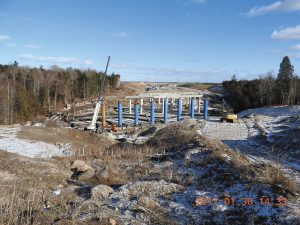
Phase 2: Checking in on the 407 Highway extension
By Nate Hendley
 The second half of the ambitious Highway 407 extension, known officially as the Highway 407 East Project, is well underway in the Greater Toronto Area (GTA). Phase 2 of the project will see Highway 407 extended eastward from Harmony Road in Oshawa to Highway 35/115, near Clarington in southern Ontario. An ancillary branch, Highway 418, will link Highway 407 with Highway 401 to the south. Part of Phase 2 will be finished later this year, with the entire project slated for completion in 2020.
The second half of the ambitious Highway 407 extension, known officially as the Highway 407 East Project, is well underway in the Greater Toronto Area (GTA). Phase 2 of the project will see Highway 407 extended eastward from Harmony Road in Oshawa to Highway 35/115, near Clarington in southern Ontario. An ancillary branch, Highway 418, will link Highway 407 with Highway 401 to the south. Part of Phase 2 will be finished later this year, with the entire project slated for completion in 2020.
Once all is done, the extension from Harmony Road to Highway 35/115 will be a 22-kilometre, four-lane roadway. The Highway 418 link will be a 10 kilometre north-south, four-lane roadway.
“Things are progressing very well and we are on schedule with the project,” says Brian Fox, communications director for the Blackbird Infrastructure Group (BBI), the construction consortium handling Phase 2.
Highway 407 is owned and controlled by the province of Ontario, as are connecting Highways 412 and 418. It is the first publicly-owned highway in the province with electronic tolls (but not toll booths or barriers). While Highway 407 is linked to the already existing Highway 407 Express Toll Route (ETR), the latter is a separate roadway leased and operated by a private firm. At present, the 407/407 ETR system starts in Burlington, weaves through various cities near Toronto, then ends at Harmony Road in Oshawa.
According to the provincial government, the Highway 407 East Project will boost traffic flow around the GTA and support future economic growth and development. It will also create business opportunities, accommodate increases in population and employment and offer emergency detour routes for Durham Region near Toronto.
The $1.2-billion design, build, finance and maintain contract for Phase 2 was awarded to the Blackbird Infrastructure 407 General Partnership (Blackbird) by Infrastructure Ontario in March, 2015. This consortium is also referred to as the Blackbird Infrastructure Group. A different consortium handled Phase 1, which covered Highway 407 from Pickering to Harmony Road. This section is now mostly complete and open to traffic, subject to newly instituted tolls.
Blackbird is a partnership between CRH Canada Group Inc., headquartered in Concord Ont. and Spanish construction giant, Cintra Infraestructuras. Construction work for Phase 2 is being done by the Dufferin Construction Company, an Oakville-Ont. based division of CRH Canada Group Inc. and Ferrovial Agroman Canada, headquartered in Mississauga, Ont. Under the terms of the contract, CRH Canada Group and Cintra are responsible for providing 30 years-worth of maintenance.
Cintra is one of the biggest private-sector developers of transportation infrastructure in the world, when it comes to number of projects and volume of infrastructure. The Blackbird website states that Cintra currently manages more than 2,180 kilometres of toll roads in 27 concessions in North America and Europe.
CRH Canada Group Inc., meanwhile, is “one of the country’s largest vertically integrated building materials and construction companies, manufacturing cement, aggregates and ready-mix concrete. Dufferin Construction Company is one of Ontario’s leading construction firms with more than 100 years’ experience building infrastructure in Ontario,” reports the same website.
Ferrovial Agroman Canada is a branch of Spanish firm Ferrovial Agroman, which has a specialty in toll roads.
Design work on Phase 2 began in March 2015 with construction commencing in October that same year.
Phase 2 actually consists of two individual segments: Phase 2A covers the area between Harmony Road and the Taunton Road/Highway 418 interchange. If all goes to plan, this part of the roadway will be open to traffic in late 2017. Phase 2B, meanwhile, extends Highway 407 from the Taunton Road/Highway 418 interchange to Highway 35/115. Phase 2B also includes the Highway 418 linkup to Highway 401. Under the current schedule, the section of roadway covered by Phase 2B should be open to traffic in 2020.
As for other specifics, Phase 2A and 2B will, according to Blackbird plans:
• Include freeway-to-freeway interchanges at Highway 401/Highway 418 and Highway 407/Highway 418;
• Include a freeway-to-freeway interchange at Highway 407/Highway 35/115;
Include interchanges at:
• Highway 407 at Enfield Road;
• Highway 407 at Regional Road 57;
• Highway 407 at Darlington Clarke Town Line;
• Highway 418 at Highway 2;
• Highway 418 at Taunton Road (partial interchange); and
• Establish a maintenance facility to provide support services.
Once Phase 2 is complete, the roadways involved will be incorporated into Highway 407’s electronic toll network. The province insists the tolls are a relative bargain and that money raised through them will ultimately benefit drivers.
“Revenue generated from the tolls will be used to help fund new infrastructure and transit projects across the province. Toll rates for Highways 407 and 412 are lower than tolls on Highway 407 ETR. The province’s rates are, on average, approximately 15 per cent lower during off-peak periods, and approximately 30 per cent lower during peak periods, as compared to Highway 407 ETR,” explains a press release from Ontario Ministry of Transportation, issued January 3, 2017.
Phase 1 saw Highway 407 extended from from Brock Road in Pickering to Harmony Road. Another segment, Highway 412, veered south from the 407, connecting with Highway 401 between Ajax and Whitby. Work on Phase 1 began in 2012. On June 20, 2016, Highway 407 was opened to traffic from Brock Road to Harmony Road. Highway 412 is also open to vehicles. Tolling on Highway 412 and the parts of Highway 407 covered in Phase 1 began February 1, 2017.
According to a project source, there are still some parts of Phase 1 that aren’t done. The Highway 401 eastbound exit ramp at Lake Ridge Road, which was part of the Phase 1 plan, has not opened but will shortly. This opening is being delayed until a final inspection of the contractor’s work can take place. A few other minor bits and pieces need to be completed as well.
As mentioned, a different cast of companies handled Phase 1. A consortium called the 407 East Development Group (407 EDG) won the billion-dollar design, build, finance and maintain contract for Phase 1 in May, 2012. 407 EDG had two equal equity partners, Cintra Infraestructuras and SNC-Lavalin Inc. of Montreal, via its SNC-Lavalin Capital division, reported a previous article in On-Site. The contract stipulates that 407 EDG is responsible for 30 years-worth of maintenance services on Phase 1 freeways.
A source from Infrastructure Ontario speaking on background explained why the same consortium didn’t handle both parts of the 407 extension. Phase 1 and Phase 2 were independent projects, stated the source, each of which featured an open, competitive procurement. Blackbird just happened to earn the highest score during the Phase 2 evaluation process by the province of Ontario and was awarded the gig.
While the teams doing the work might be different, there are significant similarities between Phase 1 and Phase 2.
For a start, both feature a Superpave asphalt mix and involve an immense amount of materials. Phase 2 alone will entail the estimated use of 540,000 metric tonnes of asphalt, 72,000 cubic metres of concrete, 650 concrete girders, two structures of steel girders and 10,000 metric tonnes of re-bar, among other supplies, states Blackbird.
Just as with Phase 1, Phase 2 has involved a series of community consultations. Key to these consultations are “Public Information Centres” (PICs)—events where citizens can discuss various matters with Highway 407 project organizers. Officials at PIC sessions have provided information on environmental concerns, property issues, agricultural agreements, construction timelines, storm water management, surface water monitoring, procurement processes, selling and relocating heritage structures, etc. Community consultations have also been a vehicle to garner input from Aboriginal groups.
Once again, limiting damage to flora and fauna is a top priority. To this end, Phase 2 involves restoring forest and wetland at a 1:1 replacement ratio (a commitment that encompasses 35 hectares of forest and 19 hectares of wetland), establishing 77 hectares of nesting habitat for Bobolink and Eastern Meadowlark birds, planting 40 butternut tree stems, building a dozen nesting kiosks for barn swallows along with four nesting structures for bats and constructing 18 highway bridges and culverts for wildlife passage, states BBI.
Noise pollution is also on the agenda. To dampen the sound of cars and trucks zooming along the asphalt, a noise wall approximately 1.35 kilometres in length is going to be built on the south side of Highway 407, near the hamlet of Hampton.
For its part, the Ontario government seems quite content with how things are progressing on Phase 2 of the Highway 407 extension.
“We are pleased with the pace of construction. BBI has been fortunate with great weather throughout 2016. As with any project, there are scheduling challenges but the province is pleased with BBI’s efforts to mitigate the impact of these,” says Calvin Curtis, manager of major projects, Central Region, Ontario Ministry of Transportation.
Scheduling challenges aside, if work continues at its current rate, drivers can expect to be motoring on at least part of the Phase 2 extension in less than one year’s time.





